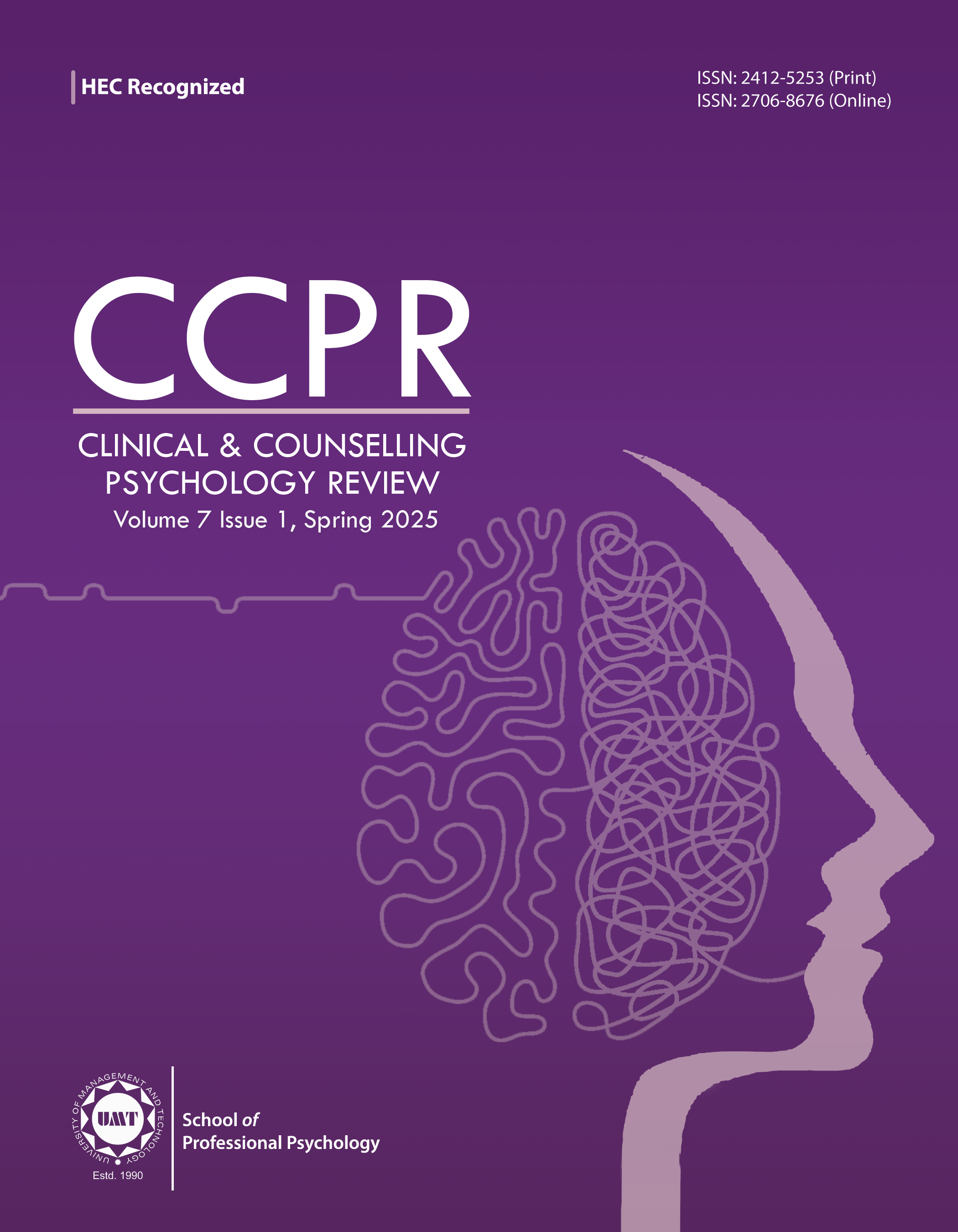Experiences of Young Clinical Psychologists Dealing with Clients having Different Sexual Orientations
Abstract
 Abstract Views: 0
Abstract Views: 0
An exciting and challenging avenue for young clinical psychologists is to work with clients having different sexual orientations. The existing literature lacks the experience-based reporting of such challenges. Hence, by exploring these challenges, the training programs can be better planned. Hence, the current qualitative study used the phenomenology approach to explore the challenges experienced by young clinical psychologists dealing with clients having different sexual orientations. A purposive sample of eight young clinical psychologists was selected for a semi-structured interview. The descriptive phenomenology analysis identified four themes: (1) “training barrier”; (2) “construct diversity issues”; (3) “cultural challenges”; and (4) “therapists’ biases”. The common challenge experienced by the participants was the training barrier regarding assessment and intervention for mental health concerns of the clients having different sexual orientations. The results highlight the importance of incorporating the perspective of young clinical psychologists to plan better training programs in order to make them competent mental health service providers.
Downloads
References
Ahmed, M. B. (2006). Homosexuality: An Islamic perspective. Journal of the Islamic Medical Association of North America, 38(1), 27–33. https://doi.org/10.5915/38-1-6275
American Psychological Association. (2012). Guidelines for psychological practice with lesbian, gay, and bisexual clients. The American Psychologist, 67(1), 10–42. https://doi.org/10.1037/a0024659
Arambula, C. (2015). Heterosexism, harassment, discrimination, and coping mechanisms among lesbian, gay, bisexual, transgender, and questioning individuals (Publication No. 3731767) [Doctoral dissertation, Texas A&M University-Kingsville]. ProQuest Dissertations & Theses.
Bailey, J. M., Vasey, P. L., Diamond, L. M., Breedlove, S. M., Vilain, E., & Epprecht, M. (2016). Sexual orientation, controversy, and science. Psychological Science in the Public Interest, 17(2), 45–101. https://doi.org/10.1177/1529100616637616
Bowers, A., & Bieschke, K. J. (2005). Psychologists' clinical evaluations and attitudes: An examination of the influence of gender and sexual orientation. Professional Psychology: Research and Practice, 36(1), 97–103.
Braun, V., & Clarke, V. (2006). Using thematic analysis in psychology. Qualitative Research in Psychology, 3(2), 77–101. https://doi.org/10.1191/1478088706qp063oa
Cleveland Clinic. (2025, February 18). Psychologist. https://my.clevelandclinic.org/health/articles/22679-psychologist
Cook, C. C. (2021). The causes of human sexual orientation. Theology & Sexuality, 27(1), 1–19. https://doi.org/10.1080/13558358.2020.1818541
Creswell, J. W. (2014). Research design: Qualitative, quantitative and mixed methods approaches (4th ed.). Sage Publications.
Eliason, M. J., & Schope, R. (2001). Does “don't ask don't tell” apply to health care? Lesbian, gay, and bisexual people's disclosure to health care providers. Journal of the Gay and Lesbian Medical Association, 5, 125–134. https://doi.org/10.1023/A:1014257910462
Fowler, J. A., Buckley, L., Muir, M., Viskovich, S., Paradisis, C., Zanganeh, P., & Dean, J. A. (2023). Digital mental health interventions: A narrative review of what is important from the perspective of LGBTQIA+ people. Journal of Clinical Psychology, 79(11), 2685–2713. https://doi.org/10.1002/jclp.23571
Goldfried, M. R., & Drescher, J. (2012). What constitutes effective consultation for therapists working with lesbian, gay, and bisexual individuals? Professional Psychology: Research and Practice, 43(5), 478–485. https://doi.org/10.1037/0735-7028.36.1.66
Haldeman, D. C. (2016). Therapeutic competence in sexual orientation. In M. M. Lebowitz (Ed.), Competence in clinical practice: A guidebook for the competency-focused training of psychological practitioners (pp. 65–85). Oxford University Press.
Hatzenbuehler, M. L., Rutherford, C., McKetta, S., Prins, S. J., & Keyes, K. M. (2020). Structural stigma and all-cause mortality among sexual minorities: Differences by sexual behavior? Social Science & Medicine, 244, Article e112463. https://doi.org/10.1016/j.socscimed.2019.112463
Isaiah, A. B. (2012). Knowledge and attitude of undergraduate students towards homosexuality and its implication on social adjustment: A study of Caritas university Amorji-Nike, Emene, Enugu State [Bachelor thesis, Caritas University]. Studocu. https://www.studocu.com/row/document/university-of-ibadan/clinical-psychology-materials/knowledge-and-attitude-of-undergraduate-students-towards-homosexuality/74675990
Kaczmarek, P. (2006). Counseling psychology and strength-based counseling: A promise yet to fully materialize. The Counseling Psychologist, 34(1), 90–95. https://doi.org/10.1177/0011000005282371
Levounis, P., & Drescher, J. (2010). Psychiatrists' attitudes toward DSM-5 proposals for paraphilias: Results from an online survey. Journal of Sexual Medicine, 7(5), 1886–1893. https://doi.org/10.1007/s10508-010-9657-5
Marshal, M. P., Dietz, L. J., Friedman, M. S., Stall, R., Smith, H. A., McGinley, J., Thoma, B. C., Murray, P. J., D’Augelli, A. R., & Brent, D. A. (2011). Suicidality and depression disparities between sexual minority and heterosexual youth: A meta-analytic review. Journal of Adolescent Health, 49(2), 115–123. https://doi.org/10.1016/j.jadohealth.2011.02.005
McInroy, L. B., & Craig, S. L. (2017). Perspectives of LGBTQ emerging adults on the depiction and impact of LGBTQ media representation. Journal of Youth Studies, 20(1), 32–46. https://doi.org/10.1080/13676261.2016.1184243
Meyer, I. H. (2013). Prejudice, social stress, and mental health in lesbian, gay, and bisexual populations: Conceptual issues and research evidence. Psychological Bulletin, 129(5), 674–697. https://doi.org/10.1037/0033-2909.129.5.674
Meyer, I. H., Schwartz, S., & Frost, D. M. (2008). Social patterning of stress and coping: Does disadvantaged social statuses confer more stress and fewer coping resources? Social Science & Medicine, 67(3), 368–379. https://doi.org/10.1016/j.socscimed.2008.03.012
Mitchell, R. C., Davis, K. S., & Galupo, M. P. (2015). Comparing perceived experiences of prejudice among self-identified plurisexual individuals. Psychology & Sexuality, 6(3), 245–257. https://doi.org/10.1080/19419899.2014.940372
Moagi, M. M., van Der Wath, A. E., Jiyane, P. M., & Rikhotso, R. S. (2021). Mental health challenges of lesbian, gay, bisexual and transgender people: An integrated literature review. Health SA Gesondheid, 26(1), 1–12.
Morrow, S. L. (2000). First do no harm: Therapist issues in psychotherapy with lesbian, gay, and bisexual clients. In R. M. Perez, K. A. DeBord, & K. J. Bieschke (Eds.), Handbook of counseling and psychotherapy with lesbian, gay, and bisexual clients (pp. 137–156). American Psychological Association.
Ngun, T. C., & Vilain, E. (2014). The biological basis of human sexual orientation: Is there a role for epigenetics? Advances in Genetics, 86, 167–184. https://doi.org/10.1016/B978-0-12-800222-3.00008-5
Robiner, W. N., Dixon, K. E., Miner, J. L., & Hong, B. A. (2014). Psychologists in medical schools and academic medical centers: Over 100 years of growth, influence, and partnership. American Psychologist, 69(3), 230–248. https://psycnet.apa.org/doi/10.1037/a0035472
Ronzón-Tirado, R., Charak, R., & Cano-González, I. (2023). Daily heterosexist experiences in LGBTQ+ adults from Spain: Measurement, prevalence, and clinical implications. Psychosocial Intervention, 32(1), 1–10. https://doi.org/10.5093/pi2022a15
Rubin, J. D., Atwood, S., & Olson, K. R. (2020). Studying gender diversity. Trends in Cognitive Sciences, 24(3), 163–165.
Smith, M. S., Fingerhut, A. W., Gamarel, K. E., O’Cleirigh, C., Joseph, H. A., & Kershaw, T. S. (2017). Measuring sexual orientation with the Kinsey Scale: A comprehensive systematic review. Journal of Sex Research, 54(4-5), 464–497. https://doi.org/10.1080/00224499.2016.1255872








